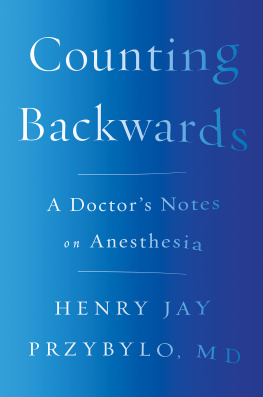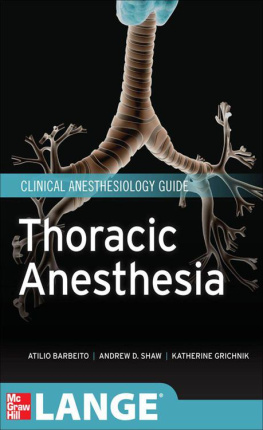Understanding Anesthesia
A Johns Hopkins Press Health Book
Understanding Anesthesia
What You Need to Know about
Sedation and Pain Control
Steven L. Orebaugh, M.D.
The Johns Hopkins University Press
Baltimore
2012 The Johns Hopkins University Press
All rights reserved. Published 2012
Printed in the United States of America on acid-free paper
9 8 7 6 5 4 3 2 1
The Johns Hopkins University Press
2715 North Charles Street
Baltimore, Maryland 21218-4363
www.press.jhu.edu
Library of Congress Cataloging-in-Publication Data
Orebaugh, Steven L.
Understanding anesthesia: what you need to know
about sedation and pain control / Steven L. Orebaugh.
p. cm. (A Johns Hopkins Press health book)
Includes bibliographical references and index.
ISBN -13: 978-1-4214-0316-8 (hardback)
ISBN -13: 978-1-4214-0317-5 (pbk.)
ISBN -10: 1-4214-0316-1 (hardcover)
ISBN -10: 1-4214-0317-X (pbk.)
1. AnesthesiaPopular works. 2. AnesthesiologyPopular works. I. Title.
RD 81.074 2011
617.96dc23 2011016275
A catalog record for this book is available from the British Library.
Special discounts are available for bulk purchases of this book.
For more information, please contact Special Sales at 410-516-6936
or specialsales@press.jhu.edu.
The Johns Hopkins University Press uses environmentally friendly
book materials, including recycled text paper that is composed of
at least 30 percent post-consumer waste, whenever possible.
The facing page of this book is an extension of this copyright page.
Note to the Reader: The information in this book should not be considered a substitute for the advice of qualified medical professionals. Patients should always consult qualified medical professionals when considering surgery or other medical procedures involving anesthesia.
All efforts have been made to ensure the accuracy of the information contained in this book as of the date of publication. The author and the publisher expressly disclaim responsibility for any adverse outcomes arising from the use or application of the information contained herein.
The author and publisher have made reasonable efforts to determine that the selection and dosage of drugs, devices, and treatments discussed in this text conform to the practices of the general medical community. The drugs, devices, and treatments described do not necessarily have specific approval by the U.S. Food and Drug Administration for use as they are recommended. In view of ongoing research, changes in governmental regulations, and the constant flow of information relating to drug therapy and drug reactions, the reader is urged to check the package insert of each drug for any change in indications and dosage and for warnings and precautions. This is particularly important when the recommended agent is a new and/or infrequently used drug.
Contents
Understanding Anesthesia
Chapter 1
Introduction to Anesthesia and Surgery
 What is anesthesia?
What is anesthesia?
Who is my anesthesiologist?
How will I be prepared for anesthesia?
What are the different techniques of anesthesia?
What is recovery from anesthesia like?
You may be reading this book because you recently had surgery or because you are scheduled for a surgical procedure in the near future. Practically speaking, almost every one of us could benefit from understanding all the events surrounding a surgical procedure, since most people undergo surgery at some point in their lives. In fact, nearly 10 percent of the U.S. population undergoes surgery (or another procedure requiring anesthesia) every year! Anesthesia is a component of most surgical procedures, although it is not always administered by an anesthesiologist or nurse anesthetist. Sometimes, the surgeon provides local anesthesia, with or without a mild degree of sedation.
In this book I primarily discuss anesthesia as it relates to procedures and surgeries that require anesthesia and that are to some degree painful. Many books and articles discuss the usefulness and safety of anesthesia. This book is different. I only briefly discuss anesthesia as a profession and touch on issues of safety in the perioperative period (the period immediately before, during, and after surgery). The focus instead is on two forms of anesthesia: general (sleeping) and regional (numbing). I separate these two forms in this book for the purpose of comparing them, but in practice, considering them as separate entities is overly simplistic because the two forms are frequently employed together, in complementary fashion. After considering each technique in isolation, we will see why in practice they are often used together and why this may be beneficial to you for surgery.
Anesthesia can be defined in various ways. For many people, it is synonymous with being unconscious, but anesthesiologists deliver regional anesthesia to thousands of pregnant women in labor every day, most of whom remain awake and are able to participate in the birth process. While many gastrointestinal procedures and other endoscopic interventions require brief anesthesia to ensure comfort during the procedure, the patient feels little or no pain once the procedure has been completed, so the role of regional anesthesia after the procedure is minimal.
Rather than confine the definition of anesthesia to a lack of awareness, lets examine what physicians try to do when they administer anesthesia. In essence, they attempt to make a painful or noxious procedure tolerable, or render a patient unable to perceive the discomfort that accompanies the procedure. The details of your anesthesia will vary with your desires and those of your surgeon, the degree of stimulation during the procedure, the nature of the surgery itself, and even your own physiology and personality.
There are four categories of anesthesia to consider:
1. local anesthesia (the injection of numbing medications only, typically right at the site of the surgical incision)
2. sedation (which, in its extreme, becomes general anesthesia)
3. general anesthesia (complete unresponsiveness, even to pain)
4. regional anesthesia (numbing medications placed in the spine, or in the nerves of the extremities, often used in concert with sedation)
The most basic means of providing an anesthetic might appear to be general anesthesiaputting a patient to sleepbut there are other ways of assuring adequate anesthesia. For procedures that are less invasive or painful, mere sedation suffices to keep many patients comfortable. Or, a surgeon or other physician may opt for injecting local anesthetic medications (similar to procaine, or Novocaine) into the area to be incised (cut) or punctured. A local is generally used by physicians when sewing up a wound in the emergency department, for example. For many other procedures, sedation is combined with local anesthetic injections to provide pain control and an acceptable lack of awareness of the procedure.
Individual surgeons use different approaches to anesthesia for similar surgical procedures. One surgeon working on a painful foot condition may request intravenous sedation to keep a patient comfortable while he or she numbs the foot with an injection of local anesthesia. A second surgeon may request that the anesthesiologist perform a regional anesthetic block of the entire lower leg, followed by the administration of sedative medications in the operating room. A third surgeon, suspecting that the patient may be unwilling or unable to tolerate a procedure under sedation, might request a general anesthetic for the same procedure. Light degrees of sedation may be provided by an injection or an oral medication given in the preoperative hold area before the procedure begins. When greater degrees of sedation are required, however, anesthesiologists and nurse anesthetists will adjust, or
Next page








 What is anesthesia?
What is anesthesia?